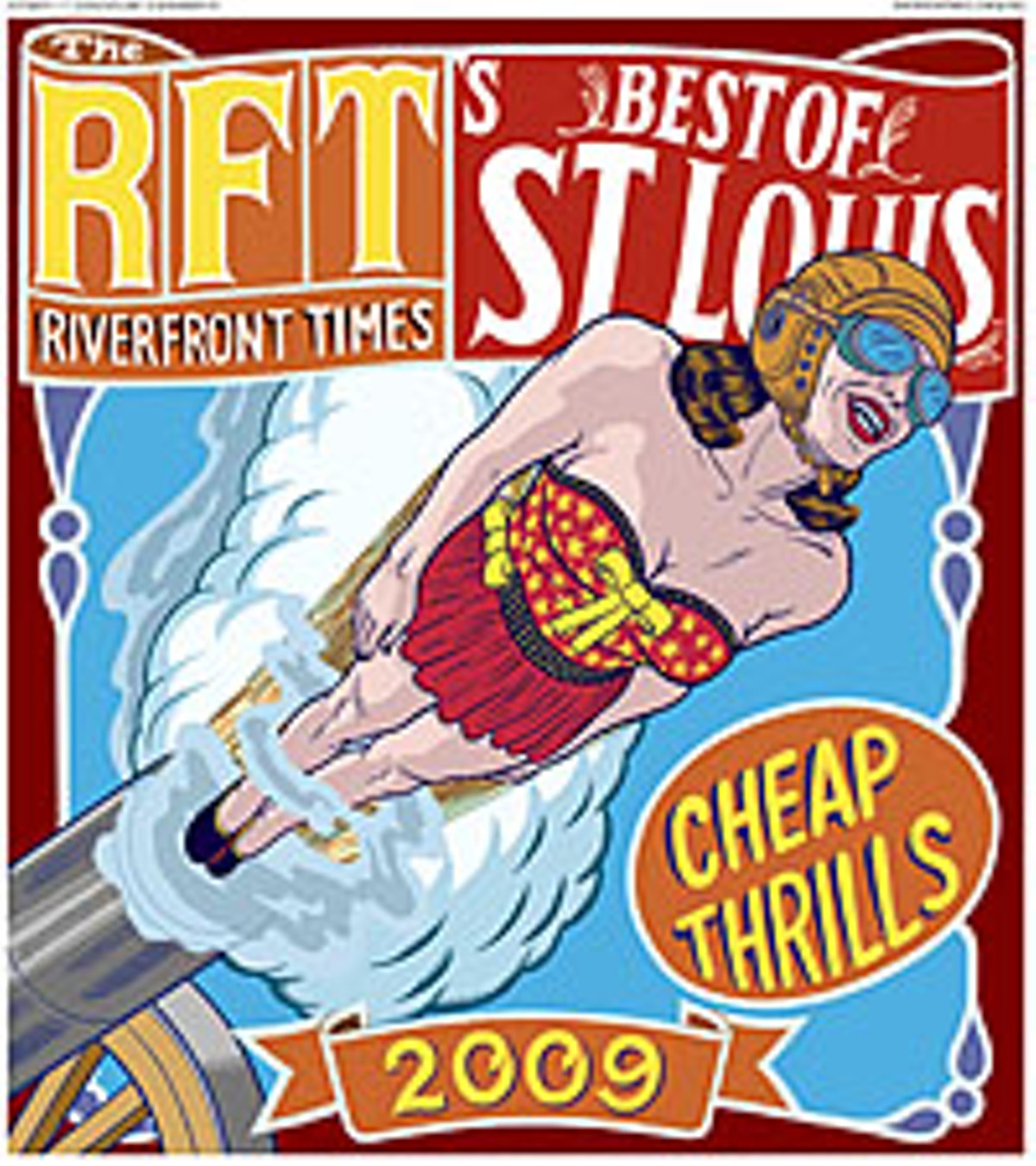In The Subject Was Roses, a young soldier returns home from World War II. He went to war as a boy; he has returned as a man. But he's still a son, and he must deal with the new family dynamics that the war has wrought. What remains most memorable about Avalon Theatre Company's staging of Frank D. Gilroy's 1964 Pulitzer Prize-winning drama is the poignant portrayal by Whit Reichert as John Cleary, the affable failure of a father. Always quick with a quip, John stands out as the showy role in what is essentially a quiet play. Reichert, who is so deft with comedy, could have played the laughs — and then played against the laughs — and acquitted himself handily. Instead he chose to dig. Reichert shed light into the shafts of John's soul so revelatory and painful, a viewer found himself wanting to turn away and look elsewhere. But there was no place for Reichert to turn, so he kept digging until he struck a vein of truth in a play that in lesser hands might have seemed merely old.
In Rebecca Gilman's involving play, Dana is a frustrated artist who ends up in a sanitarium and then — when she realizes her health insurance is about to run out — pretends to be colorful slugger Darryl Strawberry in order not to get evicted. In this NonProphet Theater Company venture, Michelle Hand's Dana was so bravura, the temptation might be to say she hit it out of the park. But a sports pun doesn't describe the extent to which Hand, when she's percolating, savors a character. If you watch baseball on TV, you know the wide-eyed smile that ensues after someone catches a foul ball and then gives that ball to the nearest kid. That same smile seems to lurk just under the mask of Hand's various onstage personas. It matters not whether the next play is comedy or drama, contemporary or period, large role or small, Hand always seems to be the nearest kid. There is no such thing as a Michelle Hand role. She's like the dancer in A Chorus Line who proclaims, "I can do that." More often than not, Hand can.
This sliver of a nonprofit gallery, which occupies a brightly renovated storefront on Cherokee Street's antique row, admirably maintains sure footing in progressive art practices and timeworn good neighborliness. Founded in 2006 by St. Louis artist Juan William Chávez and co-operated by a rotating cast of thoughtful collaborators, this self-described art laboratory consistently offers programming that's exponentially larger in outreach and scope than the modest size of its former shoe repair-shop space and similarly diminutive staff of volunteers. Luring artists from the St. Louis region and such far-flung locales as Turkey, Greece, Pakistan and beyond, Boots succeeds in performing a uniquely plainspoken analysis of our daily lives, finding high art in, say, the way friendships are conducted or how pedestrians interact with their surroundings. Highlights from this past year alone include conceptualist Serkan Özkaya transforming a ream of printer paper into a static windstorm/commentary on artistic influence; the punk exuberance of the group show Bad Moon Rising 3 piling together every outcry of political malaise for a powerful installation of contemporary discontent; and Slinger II, an annual group show of local art curated by St. Louisan Cole Root with exuberance and clarity, issuing a healthy diagnosis for our native creative output. Never short on ideas, Boots also produces Boot Print, a journal of interviews and essays by artists, curators and art professionals, furthering the space's mission to engage the community.
"Think about your future!" the woman demanded, her sense of purpose giving her a powerful presence despite her petite frame. "You students who are here on scholarships — you are putting that all at risk." The year was 2009, but fourth-grade teacher Sue Ellen Turner was taking her students back to 1960. The place was a public school in St. Louis, but Turner was evoking Fisk University in Nashville, a historically black college integral to the nonviolent resistance of the civil-rights movement. Turner portrayed Fisk's academic dean, pleading with students to focus on their education rather than risk arrest and expulsion. Her Interchange partner, Metro Theater Company's Emily Petkewich, brought to life the white civil-rights organizer who encouraged Fisk students to participate in lunch-counter protests. Throughout the four-month program, the fourth graders went beyond textbooks and reports. They lived the exciting, tense, challenging, world-changing days of 1960s America. This is how Interchange works: The organization, a COCA program that partners public schools with more than 30 arts groups, uses the arts-integration model to teach students key skills and concepts. Through drama, dance, creative writing and visual art, Interchange partnerships bring immediacy and insight to a variety of subjects. The organization utilizes a concept well known to good teachers: the notion that not all children learn in the same way and that the arts can and do unlock academic potential. Tellingly, during the four-month program in Ms. Turner's classroom, not one student missed a single day of school. Think about your future, St. Louis.
Save for the occasional spurt of Mexican-jumping-bean stage moves, nearly everything about Bad Folk was understated. Vocalist Tim Rakel's gravelly monotone and strummy banjo, as well as plenty of noir-twang color fit the band's macabre-folk tales and desolate-road-trip revelries. It's not surprising, then, that the October 2008 split was just as low-key: With nary an official announcement, Bad Folk played its last show at Mangia Italiano and called it quits. The dissolution delayed the release of the band's highly anticipated Part of the Problem LP (although it saw a posthumous release online earlier this year). Bad Folk fans needn't worry about its members disappearing, though: Rakel, for one, continues performing in bands around town, including droning folkies the May Day Orchestra and harder-edged act the Union Electric.
The young upstarts are cagey veterans now, heading into their tenth year of playing bluegrass — real bluegrass with Scruggs-style banjo, jaw-dropping mandolin breaks and taut and lonesome harmonies — the kind you expect from the founding generation of the style but rarely hear from the acoustic jam bands that only aspire to an opening slot at Wakarusa. Cumberland Gap's music is more rewarding: Led by the bluesy phrasing and modern songwriting flair of Greg Silsby, the band leans forward as one, focused and tight, and still takes chances with the American folk and country songbook, making covers of Hank Williams and Gordon Lightfoot wholly their own.
From the top of his broad-brimmed hat to the tips of his gleaming shoes, Big George Brock is most definitely a man of style. The 77-year-old's eye-catching outfits, imposing physical stature and outsize personality make him the focus of attention wherever he goes, even if his showmanship and energy onstage would be impressive even in a man half his age. As a musician, Brock is also a man of substance, for his blues are as authentic as you'll find anywhere. He specializes in a raucous, electrified blend of guitars, harmonica and drums that evokes both Mississippi juke joints and big-city barrooms, all topped off by his commanding vocals and scalding harmonica licks. Having recently released a live CD and provided the title song for the award-winning blues documentary M for Mississippi, Brock has now acquired a new touring vehicle: a plus-size van he's had decked out, in true old-school style, with a considerably larger-than-life-size portrait of himself. May Big George keep on rolling for many years to come.
Sure, you could fill a small library with recent books on how and why crystal methamphetamine wormed its way into America's heartland. But until you've read Methland, you ain't read nothing. St. Louisan Nick Reding spent nearly four unnerving years wading deep into the life of Oelwein, Iowa, a meatpacking town of 6,772 whose very soul was blackened by crank. Through old-fashioned shoe-leather reporting, Reding offers an eyeball-frying account of one drug's power to alter an entire culture — the domestic violence, the exploding backyard crank labs, the trembling, nostril-scarred addicts, the desperate corn farmers reduced to selling small-time cooks the nitrate-rich anhydrous ammonia they spray on their fields. In one unforgettable chapter, Reding writes of the winter night when Roland Jarvis, a 35-year-old divorced dad, blew himself up: "Following one of his trips outside, Jarvis looked down and saw what he thought was egg white on his bare arms. It was not egg white; it was the viscous state of his skin now that the water had boiled out of it. Jarvis flung it off himself, and then he saw that where the egg white had been he could now see roasting muscle. His skin was dripping off his body in sheets."
Utter the word "casino" and some people's eyes will light up as bright as the Vegas strip as they imagine swank lounges and $10,000 poker hands. Utter that same word and other people will scowl as they envision pensioners robotically feeding quarters into slot machines. Or avoid this dichotomy altogether and just say: "Let's go to Ameristar St. Charles." This is a casino that everyone can enjoy — from the blackjack diehard to the person who won't risk a nickel. Ameristar situates its tables and machines off the main concourse. Rather than walking into a sensory-deprivation tank of beeps and bings, guests walk into a sunny, airy streetscape lined with cafés and full-service restaurants — everything from pancakes to crab legs to the Vietnamese noodle soup mì hoành thánh. The entertainment's topnotch, too — particularly the national acts that drop by the gorgeous Bottleneck Blues Bar. A little more than a year ago, Ameristar completed more than $260 million in renovations; the hotel is totally updated (the rooms and spa are downright posh), and Home nightclub is one of the most visually impressive venues in the St. Louis region. If you can't find a way to win at Ameristar, odds are you're not trying.








